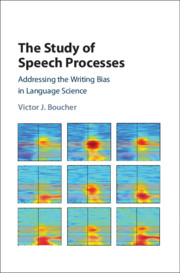Book contents
- The Study of Speech Processes
- The Study of Speech Processes
- Copyright page
- Contents
- Figures
- Tables
- Abbreviations
- Preface
- Introducing a Fundamental Problem of Language Science
- Part I Questions of Ontology: Writing and the Speech–Language Divide
- Part II Questions of Epistemology: The Role of Instrumental Observations
- Part III The Structure of Speech Acts
- 6 Utterances as Communicative Acts
- 7 Relating to Basic Units: Syllable-Like Cycles
- 8 Relating Neural Oscillations to Syllable Cycles and Chunks
- 9 Breath Units of Speech and Their Structural Effects
- Part IV The Processing of Speech Meaning
- References
- Index
6 - Utterances as Communicative Acts
from Part III - The Structure of Speech Acts
Published online by Cambridge University Press: 14 January 2021
- The Study of Speech Processes
- The Study of Speech Processes
- Copyright page
- Contents
- Figures
- Tables
- Abbreviations
- Preface
- Introducing a Fundamental Problem of Language Science
- Part I Questions of Ontology: Writing and the Speech–Language Divide
- Part II Questions of Epistemology: The Role of Instrumental Observations
- Part III The Structure of Speech Acts
- 6 Utterances as Communicative Acts
- 7 Relating to Basic Units: Syllable-Like Cycles
- 8 Relating Neural Oscillations to Syllable Cycles and Chunks
- 9 Breath Units of Speech and Their Structural Effects
- Part IV The Processing of Speech Meaning
- References
- Index
Summary
Utterances are communicative acts. They bear observable structures that relate to constraints on actions and the processing of sequences of actions. In viewing utterances this way, rather than as sentences on a page, it is essential to consider that oral communication rests on a basic speaker–listener parity, which is achieved through motor-sensory coupling.This coupling not only applies to articulatory-acoustic features but also, at a basic level, to multimodal information that binds to structures of motor speech and which serves to constitute semantic representations. Research on motor-sensory coupling is discussed with a focus on the adaptation of couplings with speech experience. These adaptations entail different types of learning, including reinforcement and supervised and Hebbian learning, that relatecortical and subcortical processes. Whereas motor-sensory coupling at cortical levels is well known, an outline of proposals is provided bearing on the role of subcortical systems. A process of neural entrainment is presented as a pivotal principle by which multisensory information couples to structures of motor speech.
Keywords
- Type
- Chapter
- Information
- The Study of Speech ProcessesAddressing the Writing Bias in Language Science, pp. 117 - 142Publisher: Cambridge University PressPrint publication year: 2021

